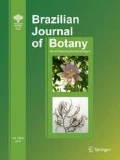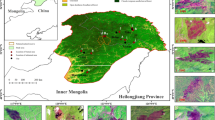Abstract
The coexistence of grasses, herbs, shrubs and trees characterizes savannas; therefore, to restore such ecosystems one should consider re-introducing all these growth forms. Currently, little is known about field establishment of most “Cerrado” (Brazilian savanna) species that could be used for restoration purposes. Most knowledge on restoration is focused on planting seedlings of tree species from forest physiognomies. Alternatively, direct seeding can be an appropriate method to re-introduce plants of different life forms to restore savannas. We evaluated the initial establishment success under field conditions of 75 “Cerrado” native species (50 trees, 13 shrubs, and 12 grasses) in direct seeding experiments in four sites in Central Brazil for 2.5 years. For that, we tagged and measured tree and larger shrub species and estimated ground cover by small shrub and grass species. Sixty-two species became established (42 trees, 11 shrubs and 9 grasses) under field conditions. Thirty-eight of the 48 tagged species had relatively high emergence rates (>10%) and 41 had high seedling survival (>60%) in the first year. Among grasses and small shrub species, Andropogon fastigiatus Sw., Aristida riparia Trin., Schizachyrium sanguineum (Retz.) Alston, Lepidaploa aurea (Mart. ex DC.) H.Rob., Stylosanthes capitata Vogel, S. macrocephala M.B.Ferreira & Sousa Costa, Achyrocline satureioides (Lam.) DC. and Trachypogon spicatus (L.f.) Kuntze had the greatest initial establishment success (up to 30% soil cover). The data on harvesting period, processing mode and field establishment for these 75 species can be readily used in restoration efforts in the “Cerrado”.
Similar content being viewed by others
References
Aires SS, Sato MN, Miranda HS (2014) Seed characterization and direct sowing of native grass species as a management tool. Grass Forage Sci 69:470–478
Assad ED, Sano EE, Masumoto R, De Castro LH, Da Silva FAM (1993) Veranicos Na Região Dos Cerrados Brasileiros Frequencia E Probabilidade de Ocorrência. Pesqui Agropecu Bras 28:993–1003
Bond WJ, Parr CL (2010) Beyond the forest edge: ecology, diversity and conservation of the grassy biomes. Biol Conserv 143:2395–2404
Brasil (2000) Lei 9.985, de 18 de Julho de 2000—Sistema Nacional de Unidades de Conservação. http://www.planalto.gov.br/ccivil_03/leis/L9985.htm. Accessed 21 Oct 2016
Cabin RJ et al (2002) Effects of light, alien grass, and native species additions on Hawaiian dry forest restoration. Ecol Appl 12:1595–1610
Campos Filho EM et al (2013) Mechanized direct-seeding of native forests in Xingu, Central Brazil. J Sustain Forest 32:702–727
Carmona R, Martins CR, Fávero AP (1999) Características de Sementes de Gramíneas Nativas Do Cerrado. Pesqui Agropec Bras 34:1067–1074
Chapin FS et al (2000) Consequences of CHANGING BIODIVERSITY. Nature 405:234–242
Chazdon RL (2008) Beyond deforestation: restoring forests and ecosystem services on degraded lands. Science 320:1458–1460
Corbin JD, D’Antonio CM (2004) Competition between native perenial and exotic annual grasses: implications for an historical invasion. Ecology 85:1273–1283
D’Antonio CM, Vitousek PM (1992) Biological invasions by exotic grasses, the grass-fire cycle, and global change. Annu Rev Ecol Syst 23:63–87
da Silva JMC, Bates JM (2002) Biogeographic patterns and conservation in the South American Cerrado: a tropical savanna hotspot. Bioscience 52:225
De Castro EA, Kauffman JB (1998) Ecosystem structure in the Brazilian Cerrado: a vegetation gradient of aboveground biomass, root mass and consumption by fire. J Trop Ecol 14:263–283
de Sousa AP (2015) Avaliação de Um Programa de Restauração de Uma Bacia Hidrográfica: Execução E Envolvimento Dos Proprietários. Dissertation, Universidade de Brasília, Brasília
Durigan G, Ivanauskas NM, Zakia MJB, De Abreu RCR (2013) Control of invasive plants: ecological and socioeconomic criteria for the decision making process. Nat Conserv 11:23–30
Engel VL, Parrotta JA (2001) An evaluation of direct seeding for reforestation of degraded lands in Central Sao Paulo State, Brazil. For Ecol Manag 152:169–181
Filgueiras TS, Fagg WC (2008) Gramineas Nativas Para Recuperação de Áreas Degradadas No Cerrado. In: Felfili CRMA, Sampaio JM, Correia JC (orgs.) Bases para a recuperação de áreas degradadas na bacia do São Francisco. Centro de Referência em Conservação da Natureza de Áreas degradadas (CRAD), Brasília, pp. 89–107
García-Núnez C, Azócar A, Silva JF (2001) Seed production and soil seed bank in three evergreen woody species from a neotropical savanna. J Trop Ecol 17:563–576
Gonçalves JVS, Albrecht JMF, Soares TS, Titon M (2008) Caracterização Física E Avaliação Da Pré-Embebição Na Germinação de Sementes de Sucupira-preta (Bowdichia virgilioides Kunth). Cerne Lavras 14:330–334
Herrick JE, Van Zee JW, Havstad KM, Burkett LM, Whitford WG (2009) Monitoring manual for grassland shrubland and savanna ecosystems: quick start, vol I. USDA-ARS Jornada Experimental Range, Las Cruces
Higgins SI, Bond WJ, Trollope WSW, Bondt WJ, Trollopet WSW (2000) Fire, resprouting and variability: a recipe for grass-tree coexistence in savanna. J Ecol 88:213–229
Hoffmann WA, Franco AC (2003) Comparative growth analysis of tropical forest and savanna woody plants using phylogenetically independent contrasts. J Ecol 91:475–484
Holl KD, Aide TM (2011) When and where to actively restore ecosystems? For Ecol Manag 261:1558–1563
Holl KD et al (2014) Efficacy of exotic control strategies for restoring coastal prairie grasses. Weed Sci Soc Am 7:590–598
Hulvey KB, Zavaleta ES (2012) Abundance declines of a native forb have nonlinear impacts on grassland invasion resistance. Ecology 93:378–388
INMET (2009) Normais Climatológicas Do Brasil 1961–1990. http://www.inmet.gov.br/portal/index.php?r=clima/normaisclimatologicas. Accessed 21 Oct 2016
Kuhlmann M (2012). Frutos E Sementes Do Cerrado Atrativos Para a Fauna: Guia de Campo. Col. Christopher W. Fagg. Rede de Sementes do Cerrado, Brasília
Kutschenko DC (2009) Fenologia E Caracterização de Frutos E Sementes de Um Cerrado Sensu Stricto, Jardim Botânico de Brasília, Distrito Federal, Brasil, Com Ênfase Nas Espécies Com Síndrome Ornitocórica. Dissertation, Universidade de Brasília, Brasília
Levine JM et al (2003) Mechanisms underlying the impacts of exotic plant invasions. Proc R Soc Lond B Biol Sci 270:775–781
Mendonça RC et al (2008) Flora Vascular Do Bioma Cerrado: Checklist Com 12.356 Espécies. In: de Almeida SP, Ribeiro JF, Sano SM (eds) Cerrado: ecologia e flora, vol 2. Embrapa Informação Tecnológica, Brasília, pp 422–442
Mori ES, Piña-Rodrigues FCM, Ivanauskas NM, Penteado de Freitas, N, Brancalion PHS, Martins RB (2012) Guia para germinação de 100 espécies nativas. In: Martins RB (org) Sementes florestais: Guia para germinação de100 espécies nativas. Instituto Refloresta, São Paulo, pp 29–141
Oliveira RS et al (2005) Deep root function in soil water dynamics in Cerrado savannas of central Brazil. Funct Ecol 19:574–581
Overbeck GE et al (2013) Restoration ecology in Brazil—time to step out of the forest. Nat Conserv 11:92–95
Palma AC, Laurance SGW (2015) A review of the use of direct seeding and seedling plantings in restoration: what do we know and where should we go? Appl Veg Sci 18:561–568
Ratter JA, Ribeiro JF, Bridgewater S (1997) The Brazilian Cerrado vegetation and threats to its biodiversity. Ann Bot Lond 80:223–230
Rodrigues RR, Lima RAF, Gandolfi S, Nave AG (2009) On the restoration of high diversity forests: 30 years of experience in the Brazilian Atlantic forest. Biol Conserv 142:1242–1251
Ruiz-Jaen MC, Aide TM (2005) Restoration success: how is it being measured? Restor Ecol 13:569–577
Salomão AN et al (2003) Germinação de Sementes E Produção de Mudas de Plantas Do Cerrado. Rede de Sementes do Cerrado, Brasília
Sano EE, Rosa R, Brito JLS, Ferreira LG (2007) Mapeamento de cobertura cegetal do bioma Cerrado: estratégias e resultados. Embrapa Cerrados, Brasilia
Silva RPRP, Oliveira DR, da Rocha GPE, Vieira DLM (2015) Direct seeding of Brazilian savanna trees: effects of plant cover and fertilization on seedling establishment and growth. Restor Ecol 23:393–401
Soares Filho B et al (2014) Cracking Brazil’s forest code. Science 344:363–364
Veldman JW et al (2015a) Toward an old-growth concept for grasslands, savannas, and woodlands. Front Ecol Environ 13:154–162
Veldman JW, Overbeck GE, Negreiros D, Mahy G, Le Stradic S, Fernandes GW, Durigan G, Buisson E, Putz F, Bond WJ (2015b) Where tree planting and forest expansion are bad for biodiversity and ecosystem services. BioSci Adv Access 20:1–8
Williams DG, Baruch Z (2000) African grass invasion in the Americas: ecosystem consequences and the role of ecophysiology. Biol Invasions 2:123–140
Young TP, Chase JM, Huddleston RT (2001) Community succession and assembly comparing, contrasting and combining paradigms in the context of ecological restoration. Ecol Restor 19:5–18
Zenni RD, Ziller SR (2011) An overview of invasive plants in Brazil. Rev Bras Bot 34:431–446
Acknowledgements
These experiments were carried out under ICMBio research permit number 33390-3. We thank several students from Restaura-“Cerrado” research group for assistance; A. Alboyadjian for English review; Fundação Grupo o Boticário de Proteção à Natureza; ICMBio; CNPq (Edital MCT/CNPq/CT-Agro 26/2010); and Embrapa/CNA partnership of the Projeto Biomas for financial support.
Author information
Authors and Affiliations
Corresponding author
Electronic supplementary material
Below is the link to the electronic supplementary material.
Rights and permissions
About this article
Cite this article
Pellizzaro, K.F., Cordeiro, A.O.O., Alves, M. et al. “Cerrado” restoration by direct seeding: field establishment and initial growth of 75 trees, shrubs and grass species. Braz. J. Bot 40, 681–693 (2017). https://doi.org/10.1007/s40415-017-0371-6
Received:
Accepted:
Published:
Issue Date:
DOI: https://doi.org/10.1007/s40415-017-0371-6




